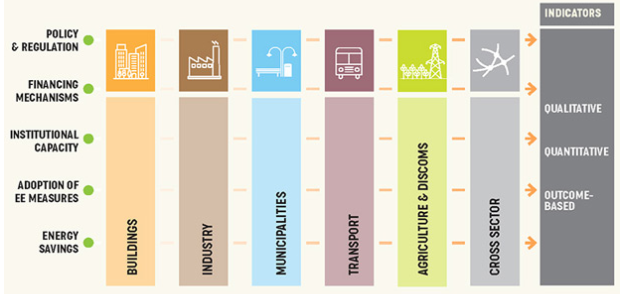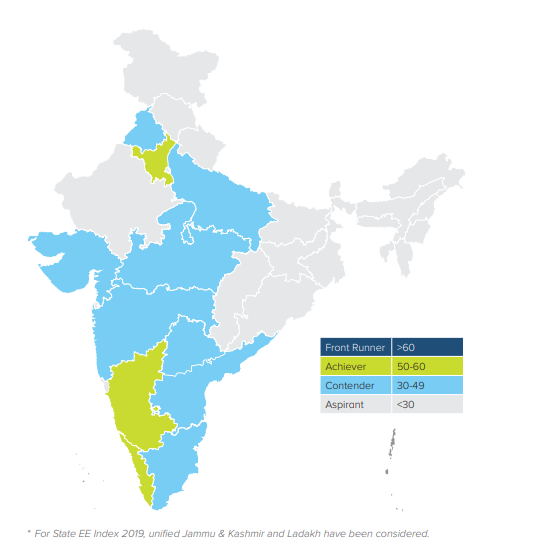Indian Economy
State Energy Efficiency Index 2019
- 11 Jan 2020
- 4 min read
Why in news
The government has released the ‘State Energy Efficiency Index 2019’. The Index tracks the progress of Energy Efficiency (EE) initiatives in states and union territories based on 97 significant indicators.
- Assessment is based on their efforts and achievements in policy and regulation, financing mechanisms, institutional capacity, adoption of energy efficiency measures and energy savings achieved.
- The index incorporates qualitative, quantitative and outcome-based indicators to assess energy efficiency initiatives, programs and outcomes in five distinct sectors – buildings, industry, municipalities, transport, agriculture, and DISCOMs.
About Index
- The first “State Energy Efficiency Preparedness Index 2018”, was launched on August 1, 2018.
- The index is developed by the Bureau of Energy Efficiency (BEE) in association with Alliance for an Energy-Efficient Economy (AEEE).
- The 2019 index has included new indicators like the adoption of Energy Conservation Building Code (ECBC) 2017, energy efficiency in MSME clusters, etc.
- Data collection: The required data were collected from the concerned state departments such as DISCOMs, Urban Development departments and other departments with the help of State Designated Agencies (SDAs).
Key Points
- Comparison: For rational comparison, States/UTs are grouped into four groups based on aggregated Total Primary Energy Supply (TPES) required to meet the state’s actual energy demand (electricity, coal, oil, gas, etc.) across sectors.
- The index categorises states as ‘Front Runner’, ‘Achiever’, ‘Contender’ and ‘Aspirant’ based on their efforts and achievements towards energy efficiency implementation.
- The top-performing states for 2019 are Haryana, Kerala and Karnataka, are in the ‘Achiever’ category.
- Manipur, Jammu & Kashmir, Jharkhand and Rajasthan performed the worst in the Aspirant groups.
- Since there isn’t state in the ‘Front runner’ category, it can be inferred that a lot more can be done at the state level to realise energy savings from energy efficiency.
- TPES grouping helps states compare their performance and share best practices within their peer group.
- The index categorises states as ‘Front Runner’, ‘Achiever’, ‘Contender’ and ‘Aspirant’ based on their efforts and achievements towards energy efficiency implementation.
- The index will help states contribute towards national goals on energy security and climate action by helping drive EE policies and program implementation at the state and local level.
- It will track progress in managing the states’ and India’s energy footprint and institutionalising the data capture and monitoring of EE activities by states.
Bureau of Energy Efficiency (BEE)
- The BEE is a statutory body under the Ministry of Power, Government of India.
- It assists in developing policies and strategies with the primary objective of reducing the energy intensity of the Indian economy.
- BEE coordinates with designated consumers, designated agencies, and other organizations to identify and utilize the existing resources and infrastructure, in performing the functions assigned to it under the Energy Conservation Act, 2001.






